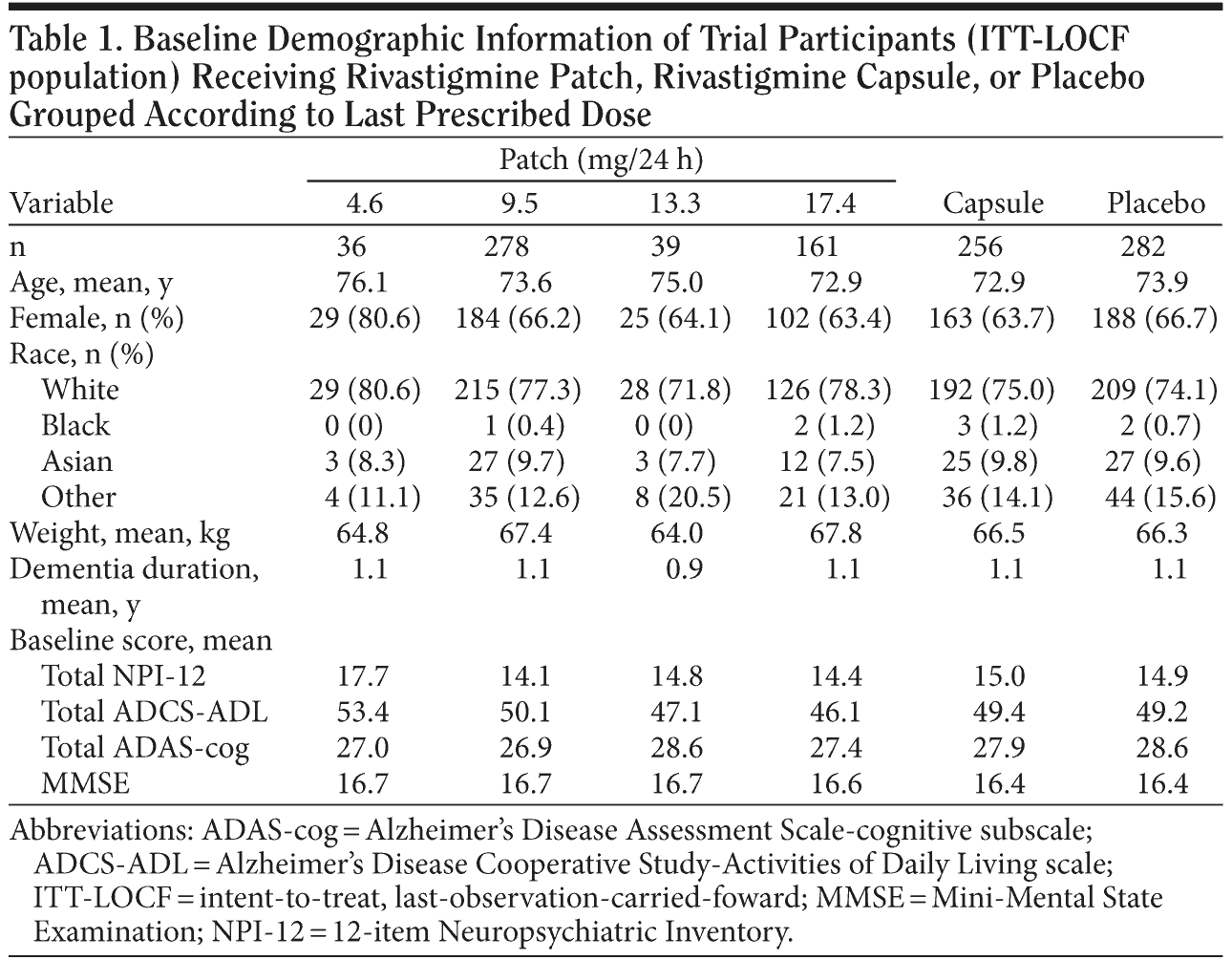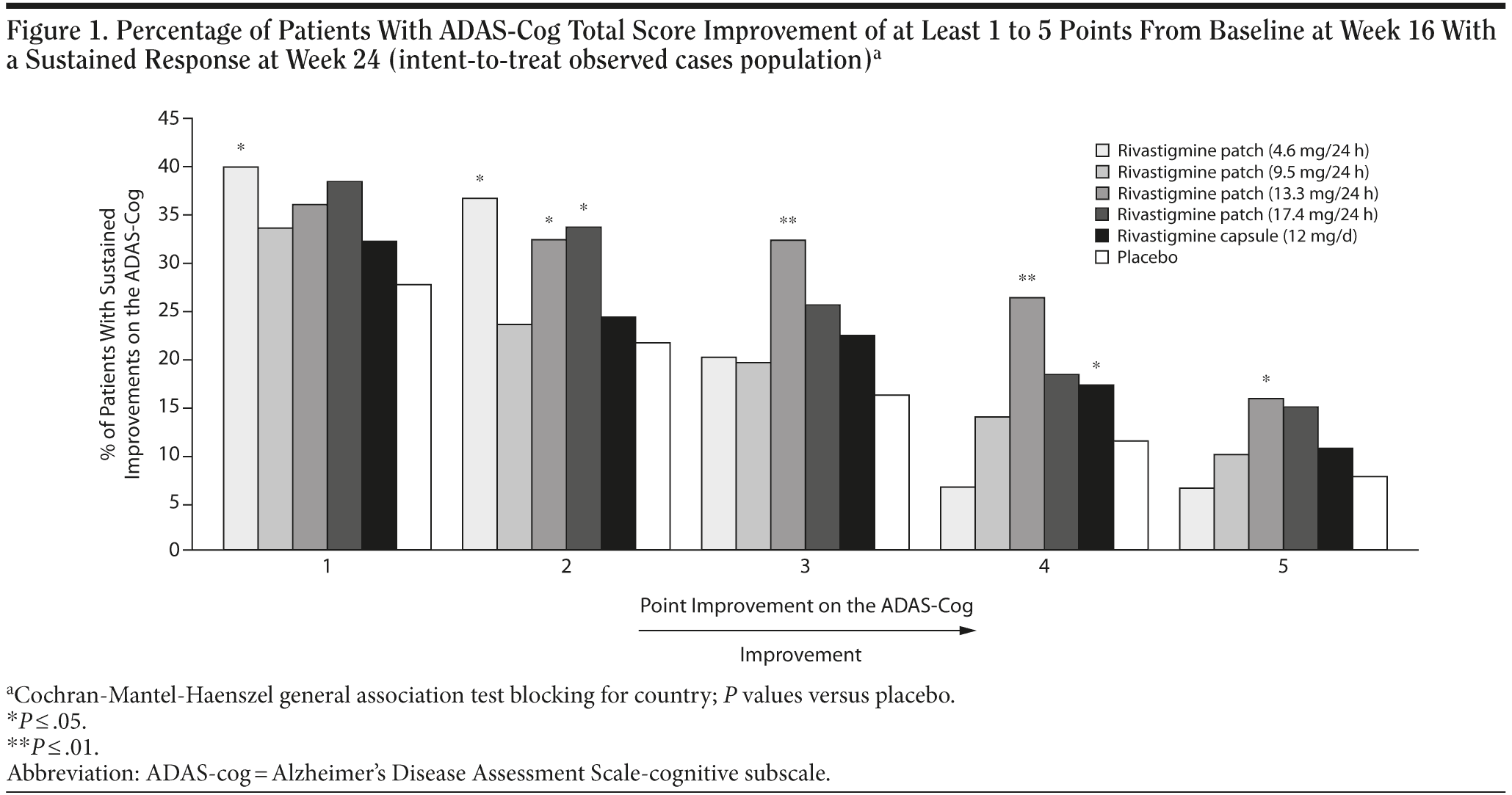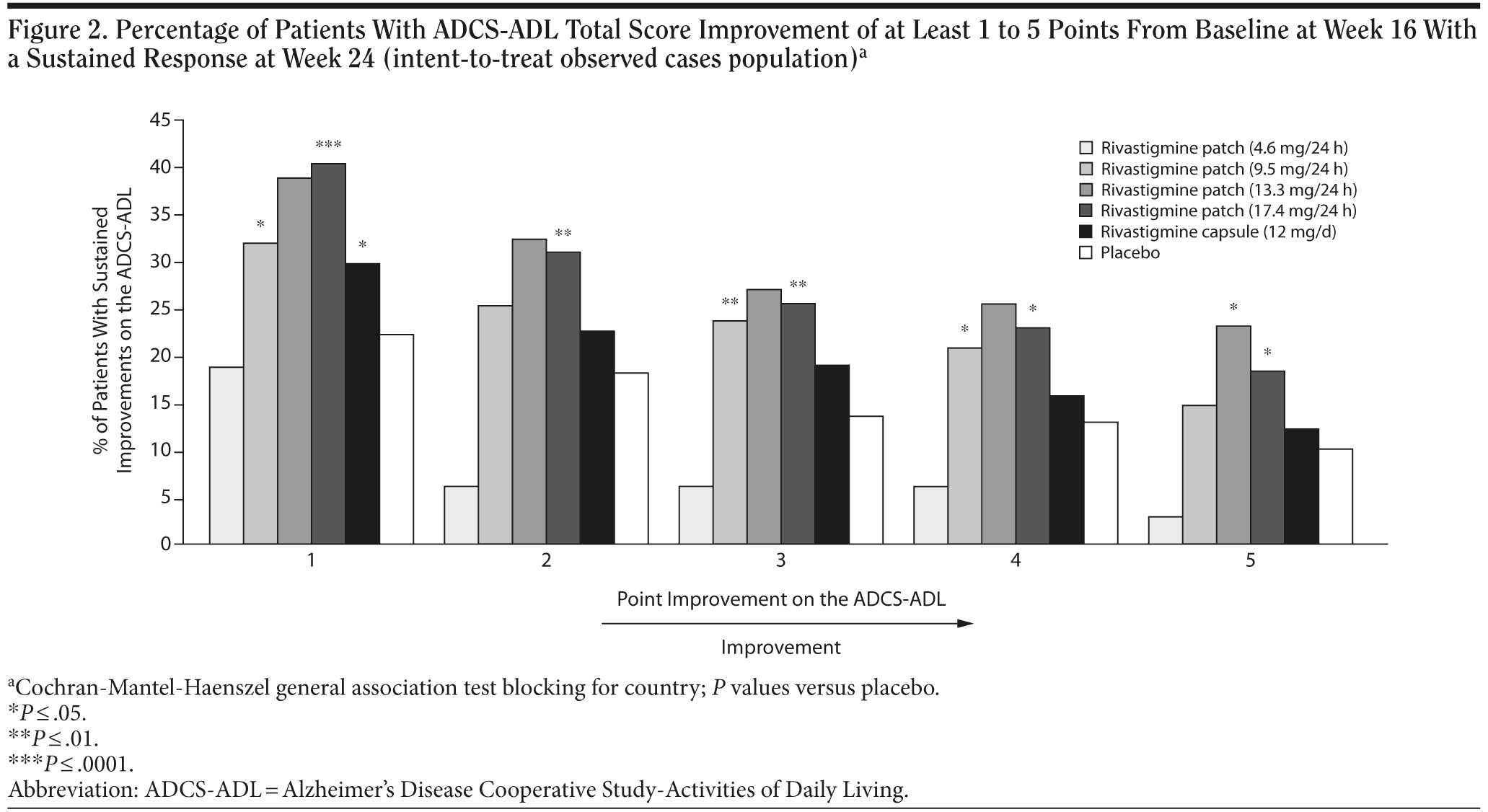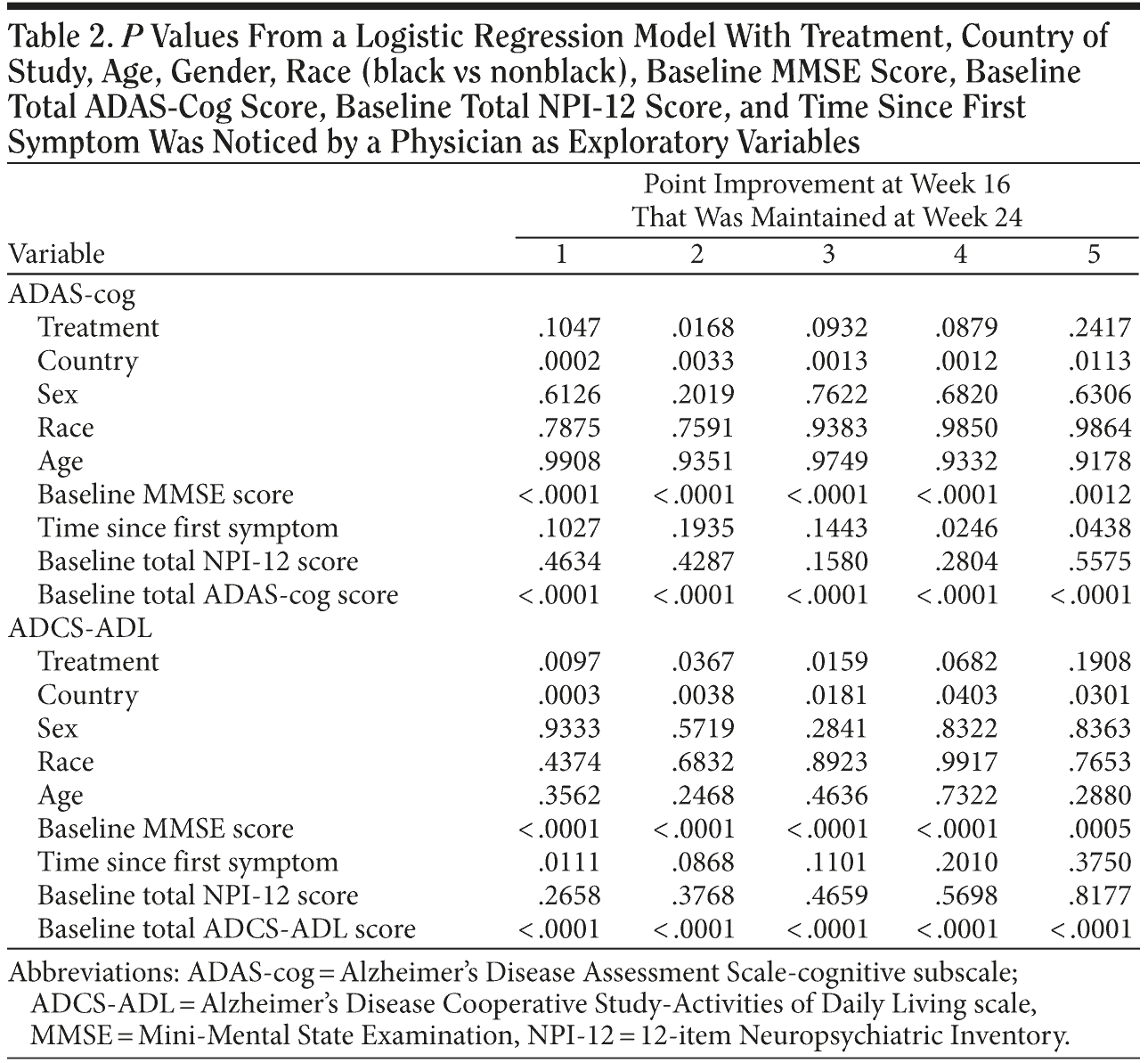Predictors of Sustained Response to Rivastigmine in Patients With Alzheimer’s Disease: A Retrospective Analysis
Objective: The cholinesterase inhibitor rivastigmine is approved for the treatment of mild to moderate Alzheimer’s disease. However, it is not possible to predict which individuals will benefit from treatment. This retrospective analysis of an international, 24-week, randomized, double-blind trial aimed to identify the percentage of persons with Alzheimer’s disease who have a sustained response with rivastigmine patch, rivastigmine capsules, or placebo; to determine the magnitude of the sustained treatment response; and to investigate baseline patient characteristics predictive of the observed sustained response.
Method: Patients who improved on the Alzheimer’s Disease Assessment Scale-cognitive subscale (ADAS-cog) and Alzheimer’s Disease Cooperative Study-Activities of Daily Living scale (ADCS-ADL) at week 16 and maintained at least the week 16 improvement at week 24 were identified as sustained responders. Treatment differences and baseline predictive factors were assessed in patients demonstrating a 1-, 2-, 3-, 4-, or 5-point sustained improvement. The first patient was screened in November 2003 and the last patient completed the study in January 2006.
Results: More persons with Alzheimer’s disease had sustained improvements on the ADAS-cog and ADCS-ADL with rivastigmine versus placebo. Sustained improvements of 4 or 5 points on the ADAS-cog or ADCS-ADL were demonstrated in the 9.5-mg/24-h rivastigmine patch (24% and 36% of patients, respectively) and 12-mg/d capsule groups (28% on both outcome measures). Factors predictive of a sustained response to treatment included baseline Mini-Mental State Examination, ADAS-cog, and ADCS-ADL scores and treatment, country of treatment, and time since first symptom was diagnosed by a physician.
Conclusions: Understanding factors predictive of sustained cholinesterase inhibitor treatment response should help to optimize Alzheimer’s disease management and encourage compliance by allowing more realistic expectations of treatment effects.
Prim Care Companion CNS Disord 2011;13(3):e1-e7
© Copyright 2011 Physicians Postgraduate Press, Inc.
Submitted: October 20, 2010; accepted December 10, 2010.
Published online: June 16, 2011 (doi:10.4088/PCC.10m01101).
Corresponding author: Carl H. Sadowsky, MD, Nova SE University, Division of Neurology, West Palm Beach, Fort Lauderdale, FL 33407 ([email protected]).
Alzheimer’s disease (AD) is a chronic neurodegenerative condition characterized by deterioration of cognitive function. It is the most common form of dementia.1 The cholinesterase inhibitor rivastigmine is approved for the symptomatic treatment of mild to moderate AD and Parkinson’s disease dementia. The rivastigmine transdermal system has been licensed for treatment of the same patient groups and allows smooth and continuous drug delivery through the skin and into the bloodstream, avoiding first-pass effects in the gut and the liver.2 The 9.5-mg/24-h rivastigmine patch (10 cm2) has been shown to deliver comparable levels of drug exposure to the highest dose of rivastigmine capsules (12 mg/d),3 but with fewer gastrointestinal side effects such as nausea and vomiting.4
Clinical Points
- It is important to understand factors predictive of sustained cholinesterase inhibitor treatment response to help optimize Alzheimer’s disease management.
- Baseline patient characteristics may aid prediction of observed sustained treatment response, which could encourage compliance by allowing more realistic expectations of treatment effects.
In clinical trials, “responders” have come to be identified as those patients showing a 4-point improvement relative to baseline on the Alzheimer’s Disease Assessment Scale-cognitive subscale (ADAS-cog)5 over 6 months.6 However, it is not currently possible to predict which individuals will benefit from treatment according to this definition. While cognition remains a key efficacy measure, additional aspects, such as activities of daily living, also need to be assessed to gain broader insight into the impact of treatment on AD patients, caregivers, and society.6
The objective of the present study was to perform a retrospective analysis of a large clinical trial in order to identify persons with AD who have a sustained treatment response to rivastigmine on the ADAS-cog or Alzheimer’s Disease Cooperative Study-Activities of Daily Living scale (ADCS-ADL). The first aim was to determine the percentage of patients that have a sustained response with the rivastigmine capsule or patch and the magnitude of the sustained response. The second aim was to determine if there were any baseline patient characteristics that would be predictive of the observed sustained treatment response. Better understanding of the factors that predict the course of AD in persons treated with cholinesterase inhibitors should aid in the allocation of the most appropriate drug modality to maximize sustained treatment response. It may encourage compliance by allowing more realistic expectations of treatment effects.
METHOD
This was a retrospective analysis of the Investigation of TransDermal Exelon in ALzheimer’s disease study (IDEAL; clinicaltrials.gov identifier NCT00099242), an international, multicenter, 24-week, randomized, double-blind, double-dummy, placebo- and active-controlled trial. The full details of the IDEAL study have been published previously.4 Briefly, inclusion criteria included an age of 50-85 years, diagnosis of dementia of the Alzheimer’s type, probable AD (DSM-IV, National Institute of Neurological and Communicative Disorders and Stroke/Alzheimer’s Disease and Related Disorders Association criteria), and a Mini-Mental State Examination (MMSE)7 score of 10-20. Exclusion criteria included an advanced, severe, progressive, or unstable disease that could interfere with study assessments or put the patient at risk; any condition other than AD that could explain the dementia; or use of an investigational drug, new psychotropic or dopaminergic agent, cholinesterase inhibitor, or anticholinergic agent during the 4 weeks prior to randomization.
Patients were recruited from 100 centers in 21 countries. The first patient was screened in November 2003 and the last patient completed the study in January 2006. The institutional review board in each country reviewed the protocol, informed consent form, and other information given to patients and caregivers, and the study was conducted according to the Declaration of Helsinki, as revised in 2000. Following baseline efficacy and safety assessments, patients were randomly assigned to 4 groups of equal size to assess the safety and efficacy of the 9.5-mg/24-h rivastigmine patch (10 cm2), the 17.4-mg/24-h rivastigmine patch (20 cm2), the rivastigmine capsule (12 mg/d), and placebo. Patients were titrated to their target dose in 4-week steps over 16 weeks, followed by an 8-week maintenance phase. Patients who had received at least 1 dose of study medication and had at least 1 safety evaluation postbaseline were considered for safety analysis, and the main efficacy analysis was based on the intent-to-treat last-observation-carried-forward (ITT-LOCF) population.
The 9.5-mg/24-h rivastigmine patch formulation and rivastigmine capsule were the focus of this study because they are both licensed for the treatment of patients with mild to moderately severe AD in the United States. Data for the 4.6-mg/24-h (5 cm2), 13.3-mg/24-h (15 cm2), and 17.4-mg/24-h (20 cm2) patches were also analyzed. For this study, efficacy analyses were performed to assess changes in scores of the ADAS-cog (a primary efficacy outcome measure of the IDEAL study) and ADCS-ADL (a secondary efficacy outcome measure of the IDEAL study)8 between week 16 and week 24 in patients treated with rivastigmine patch, rivastigmine capsule, or placebo. Patients who improved on the ADAS-cog and ADCS-ADL at week 16 and maintained at least the week 16 improvement over baseline at week 24 were identified as sustained responders.
In order to compare and extend data pertaining to the current definition of responders, response to rivastigmine was assessed in patients showing a 1- to 5-point improvement on the ADAS-cog and ADCS-ADL. Treatment differences between rivastigmine and placebo groups in patients showing a sustained response were compared using the Cochran-Mantel-Haenszel test controlled by blocking for pooled country. Predictors of sustained improvement on ADAS-cog and ADCS-ADL scores were investigated using a logistic regression model with the following explanatory variables: treatment, country of study, age, gender, race, baseline MMSE score, corresponding baseline ADAS-cog and ADCS-ADL scores, baseline 12-item Neuropsychiatric Inventory score,9 and time since first symptom was noticed by a physician. The association between ADAS-cog and ADCS-ADL scores was assessed using Pearson correlation coefficients.
RESULTS
Study Population
Of 1,195 patients enrolled in the IDEAL study, 303 patients were randomized to the 17.4-mg/24-h rivastigmine patch, 293 patients to the 9.5-mg/24-h rivastigmine patch, 297 patients to rivastigmine capsules, and 302 patients to placebo. The ITT-LOCF population comprised 1,053 patients. At the end of the study, the mean (SD) dose at week 20-24 was 9.7 (3.4) mg/d for patients receiving the rivastigmine capsule, and the mean (SD) patch size applied to patients in the 10-cm2 and 20-cm2 rivastigmine groups was 9.8 (1.0) cm2 and 16.5 (5.3) cm2, respectively.
The baseline demographics and clinical characteristics of the ITT-LOCF population, by last prescribed rivastigmine dose, are presented in Table 1. For the current study, data were available for 36 patients receiving the 4.6-mg/24-h patch as the last prescribed dose, 278 receiving the 9.5-mg/24-h patch, 39 receiving the 13.3-mg/24-h patch, 161 receiving the 17.4-mg/24-h patch, 256 receiving rivastigmine capsules, and 282 receiving placebo. There were no significant differences between treatment groups in terms of baseline demographics or clinical characteristics (all P > .05).
Sustained Responders on the ADAS-cog
There were 86 (33.6%), 61 (23.6%), 51 (19.7%), 37 (13.9%), and 27 (10.0%) patients treated with the 9.5-mg/24-h rivastigmine patch who had a 1-, 2-, 3-, 4-, and 5-point sustained response on the ADAS-cog, respectively. With rivastigmine capsules, 75 (32.2%), 58 (24.4%), 54 (22.5%), 42 (17.3%), and 26 (10.7%) patients had a 1-, 2-, 3-, 4-, and 5-point sustained response, respectively. The percentages of patients with sustained response on the ADAS-cog for each of the rivastigmine treatments and placebo are summarized in Figure 1.
On the ADAS-cog, there was a significantly higher percentage of patients with a 1-point sustained response versus placebo with the 4.6-mg/24-h patch (P = .0380). There was a significantly higher percentage of patients with a 2-point sustained response versus placebo with the 4.6-mg/24-h patch (P = .0152), 13.3-mg/24-h patch (P = .0320), and 17.4-mg/24-h patch (P = .0215). There was a significantly higher percentage of patients with a 3-point sustained response versus placebo with the 13.3-mg/24-h patch (P = .0043). There was a significantly higher percentage of patients with a 4-point sustained response versus placebo with the 13.3-mg/24-h patch (P = .0023) and rivastigmine capsules (P = .0441). There was a significantly higher percentage of patients with a 5-point sustained response versus placebo with the 13.3-mg/24-h patch (P = .0175).
Sustained Responders on the ADCS-ADL
There were 81 (31.9%), 65 (25.3%), 62 (23.7%), 55 (20.8%), and 39 (14.7%) patients treated with the 9.5-mg/24-h rivastigmine patch who had a 1-, 2-, 3-, 4-, and 5-point sustained response on the ADCS-ADL, respectively. With rivastigmine capsules, 71 (29.8%), 54 (22.5%), 46 (19.0%), 38 (15.6%), and 30 (12.3%) patients had a 1-, 2-, 3-, 4-, and 5-point sustained response, respectively. The percentages of patients with sustained response on the ADCS-ADL for each of the rivastigmine treatments are summarized in Figure 2.
On the ADCS-ADL, there was a significantly higher percentage of patients with a 1-point sustained response versus placebo with the 9.5-mg/24-h patch (P = .0266), the 17.4-mg/24-h patch (P < .0001), and rivastigmine capsules (P = .0459). There was a significantly higher percentage of patients with a 2-point sustained response versus placebo with the 17.4-mg/24-h patch (P = .0030). There was a significantly higher percentage of patients with a 3-point sustained response versus placebo with the 9.5-mg/24-h patch (P = .0053) and 17.4-mg/24-h patch (P = .0029). There was a significantly higher percentage of patients with a 4-point sustained response versus placebo with the 9.5-mg/24-h patch (P = .0265) and 17.4-mg/24-h patch (P = .0117). There was a significantly higher percentage of patients with a 5-point sustained response versus placebo with the 13.3-mg/24-h patch (P = .0395) and 17.4-mg/24-h patch (P = .0233).
Factors Predictive of Sustained Response
From a logistic regression model, on the ADAS-cog, country, baseline MMSE score, and baseline total ADAS-cog score were significantly associated with a 1- to 5-point sustained response (Table 2). Treatment was associated with a 2-point sustained response, and time since first symptom was diagnosed by a physician was associated with a 4- and 5-point sustained response.
On the ADCS-ADL, country, baseline MMSE score, and baseline total ADCS-ADL score were significantly associated with a 1- to 5-point sustained response. Treatment was associated with a 1- to 3-point sustained response, and time since first symptom was noticed by a physician was associated with a 1-point sustained response (Table 2).
There was a significant correlation between the change in ADAS-cog and ADCS-ADL scores at week 16 and week 24 for the 9.5-mg/24-h patch (P < .0001), the 17.4-mg/24-h patch (P < .0001), rivastigmine capsules (P = .0016 at week 16 and P < .0001 at week 24), and placebo (P < .0001).
DISCUSSION
This study demonstrated that a greater percentage of persons with AD have sustained improvements on the ADAS-cog and ADCS-ADL when treated with rivastigmine compared with placebo. There was a tendency for more patients to show sustained responses of smaller magnitudes on ADAS-cog or ADCS-ADL scores. Nevertheless, 24% and 28% of patients receiving the 9.5-mg/24-h rivastigmine patch and rivastigmine capsules, respectively, showed improvements of 4 or 5 points on the ADAS-cog that were sustained for the duration of the 24-week study. Similarly, 36% and 28% of patients taking the 9.5-mg/24-h rivastigmine patch and rivastigmine capsules, respectively, showed improvements of 4 or 5 points on the ADCS-ADL.
Rivastigmine treatment can lead to sustained improvements in cognition and activities of daily living, and different modalities and patch doses may be associated with different magnitudes of sustained improvement. This is consistent with previous suggestions that rivastigmine shows a dose-response effect4,10 and emphasizes the importance of patients reaching target therapeutic doses.11 Impressive sustained improvements on ADAS-cog and ADCS-ADL scores were also seen in patients treated with the higher 13.3-mg/24-h and 17.4-mg/24-h rivastigmine patch doses, respectively. These patch doses are not currently approved for the treatment of patients with AD. However, the ongoing OPTIMA trial (OPtimizing Transdermal Exelon In Mild to moderate Alzheimer’s Disease) is assessing the safety, tolerability, and efficacy of the 13.3-mg/24-h rivastigmine patch in patients with mild to moderate AD who demonstrate cognitive decline on the 9.5-mg/24-h patch. The results of this study are eagerly anticipated.
Cholinesterase inhibitors form the mainstay of treatment of mild to moderate AD; however, they are largely symptomatic therapies. While it is common for many patients to see an initial noticeable symptomatic improvement, others may experience a meaningful (but less noticeable) delay in further decline, and some decline will eventually occur in all patients.12 Cholinesterase inhibitors are used to stabilize rather than improve symptoms of the disease, and this may translate into perceived lack of treatment effect and voluntary lack of compliance; however, delay in worsening of functional, cognitive, and behavioral symptoms can only be achieved with sustained medication use.11,12
Noncompliance with AD therapies is a widespread problem and is often a barrier to effective therapy.12-15 Yet, data pooled from 2 open-label extensions of 4 randomized trials showed that patients who continued on rivastigmine treatment for up to 5 years had sustained and significant benefits over model-based untreated patients.12,16 Therefore, while these treatments may offer symptomatic benefit to those initiating treatment, their benefit can also extend to those who continue with treatment as the disease advances. Indeed, a recent review on optimal cholinesterase inhibitor therapy for AD concluded that patients should be encouraged to reach what is considered to be an optimal therapeutic dose at a given stage, and to stay on treatment long term.11 There is currently a lack of accepted measures to show improvement or slowing of decline in AD patients treated with cholinesterase inhibitors, and a greater understanding of factors that predict sustained response is warranted to identify patients most likely to continue to respond to treatment as symptoms decline.
Response to therapy with cholinesterase inhibitors in individuals with AD needs to be better defined so that physicians can determine whether their patients are benefiting from treatment and so that expectations of the patient and caregiver can be managed, thereby encouraging the patient to reach a therapeutic dose and stay on therapy long term.11 However, ethical concerns are associated with long-term placebo-controlled trials in patients with AD, owing to the approval and availability of several agents to treat the condition.17 Consequently, there are limited data describing factors that can predict the long-term response to cholinesterase inhibitors.
In order to determine what constitutes a meaningful response, the American College of Physicians and American Academy of Family Physicians developed guidelines to present the available evidence on current pharmacologic treatment of dementia.18 In their guidelines, they concluded that rivastigmine may not improve cognition as measured by the ADAS-cog but did result in clinically important improvements as measured by global assessment with the Clinician Interview-Based Impression of Change Plus Caregiver Input.19 They concluded that because the duration of trials in their review was less than 7 months, the long-term effects of treatment with rivastigmine were not known,18 further highlighting the need for factors to predict the course of AD in patients treated with cholinesterase inhibitors. In clinical trials, responders have come to be identified as those patients showing a 4-point improvement relative to baseline on the ADAS-cog over 6 months; however, it is not currently possible to predict which individuals will benefit from treatment according to this definition. In our study, we tried to identify factors that may predict sustained response to rivastigmine and found baseline MMSE score, ADAS-cog score, ADCS-ADL score, treatment, country of treatment, and time since first symptom was diagnosed by a physician to be indicative of sustained response to therapy.
Our study has several limitations. It is retrospective in nature, and patient groups were uneven in number. Data were only available for up to 24 weeks, and longer-term follow-up data would be required to fully assess the long-term value of our results. Nevertheless, the current study demonstrates sustained improvements in cognition and activities of daily living in persons with AD treated with rivastigmine. Understanding factors influencing sustained response could increase compliance by allowing more realistic expectations of efficacy. Patch doses above 9.5 mg/24 h may confer additional benefits and warrant further investigation.
Drug names: rivastigmine (Exelon and others).
Author affiliations: Division of Neurology, Nova SE University, Fort Lauderdale, Florida (Dr Sadowsky); Department of Neurology and Psychiatry, St Louis University School of Medicine, St Louis, Missouri (Dr Grossberg); and Novartis Pharmaceuticals Corporation, East Hanover, New Jersey (Drs Somogyi and Meng).
Potential conflicts of interest: Dr Sadowsky is a consultant to and has participated in speakers/advisory boards for Accera, Forest, and Novartis and has received honoraria from Pamlab. Dr Grossberg is a consultant to Janssen, Novartis, and Pfizer; has received grant/research support from Forest, Novartis, and Pfizer; and has participated in speakers/advisory boards for Forest and Novartis. Drs Somogyi and Meng are full-time employees of and stock shareholders in Novartis.
Funding/support: The Alzheimer’s disease study for which the current data were collected and the current data analyses were sponsored by Novartis. Alpha-Plus Medical Communications Ltd (Abingdon, Oxfordshire, United Kingdom) provided medical writing and editorial support in the production of this manuscript; this service was sponsored by Novartis.
REFERENCES
1. Cummings JL. Alzheimer’s disease. N Engl J Med. 2004;351(1):56-67. PubMed
2. Cummings J, Lefרvre G, Small G, et al. Pharmacokinetic rationale for the rivastigmine patch. Neurology. 2007;69(suppl 1):S10-S13. PubMed doi:10.1212/01.wnl.0000281846.40390.50
3. Mercier F, Lefרvre G, Huang HL, et al. Rivastigmine exposure provided by a transdermal patch versus capsules. Curr Med Res Opin. 2007;23(12):3199-3204. PubMed doi:10.1185/030079908X253438
4. Winblad B, Cummings J, Andreasen N, et al. A six-month double-blind, randomized, placebo-controlled study of a transdermal patch in Alzheimer’s disease: rivastigmine patch versus capsule. Int J Geriatr Psychiatry. 2007;22(5):456-467. PubMed doi:10.1002/gps.1788
5. Rosen WG, Mohs RC, Davis KL. A new rating scale for Alzheimer’s disease. Am J Psychiatry. 1984;141(11):1356-1364. PubMed
6. Winblad B, Brodaty H, Gauthier S, et al. Pharmacotherapy of Alzheimer’s disease: is there a need to redefine treatment success? Int J Geriatr Psychiatry. 2001;16(7):653-666. PubMed doi:10.1002/gps.496
7. Folstein MF, Folstein SE, McHugh PR. “Mini-mental state”: a practical method for grading the cognitive state of patients for the clinician. J Psychiatr Res. 1975;12(3):189-198. PubMed doi:10.1016/0022-3956(75)90026-6
8. Galasko D, Bennett D, Sano M, et al. An inventory to assess activities of daily living for clinical trials in Alzheimer’s disease: The Alzheimer’s Disease Cooperative Study. Alzheimer Dis Assoc Disord. 1997;11(suppl 2):S33-S39. PubMed doi:10.1097/00002093-199700112-00005
9. Cummings JL. The Neuropsychiatric Inventory: assessing psychopathology in dementia patients. Neurology. 1997;48(suppl 6):S10-S16. PubMed
10. Anand R, Messina J, Hartman R. Dose-response effect of rivastigmine in the treatment of Alzheimer’s disease. Int J Geriatr Psychopharmacol. 2000;2:68-72.
11. Small G, Bullock R. Defining optimal treatment with cholinesterase inhibitors in Alzheimer’s disease. Alzheimers Dement. 2011;7(2):177-184. PubMed doi:10.1016/j.jalz.2010.03.016
12. Small G, Dubois B. A review of compliance to treatment in Alzheimer’s disease: potential benefits of a transdermal patch. Curr Med Res Opin. 2007;23(11):2705-2713. PubMed doi:10.1185/030079907X233403
13. Singh G, Thomas SK, Arcona S, et al. Treatment persistency with rivastigmine and donepezil in a large state Medicaid program. J Am Geriatr Soc. 2005;53(7):1269-1270. PubMed doi:10.1111/j.1532-5415.2005.53384_9.x
14. Sicras-Mainar A, Vergara J, Leon-Colombo T, et al. Retrospective comparative analysis of antidementia medication persistence patterns in Spanish Alzheimer’s disease patients treated with donepezil, rivastigmine, galantamine and memantine. Rev Neurol. 2006;43(8):449-453. PubMed
15. Mauskopf JA, Paramore C, Lee WC, et al. Drug persistency patterns for patients treated with rivastigmine or donepezil in usual care settings. J Manag Care Pharm. 2005;11(3):231-251. PubMed
16. Small GW, Kaufer D, Mendiondo MS, et al. Cognitive performance in Alzheimer’s disease patients receiving rivastigmine for up to 5 years. Int J Clin Pract. 2005;59(4):473-477. PubMed doi:10.1111/j.1368-5031.2005.00524.x
17. Kawas CH, Clark CM, Farlow MR, et al. Clinical trials in Alzheimer disease: debate on the use of placebo controls. Alzheimer Dis Assoc Disord. 1999;13(3):124-129. PubMed doi:10.1097/00002093-199907000-00002
18. Qaseem A, Snow V, Cross JT Jr, et al; American College of Physicians/American Academy of Family Physicians Panel on Dementia: current pharmacologic treatment of dementia. A clinical practice guideline from the American College of Physicians and the American Academy of Family Physicians. Ann Intern Med. 2008;148(5):370-378. PubMed
19. Boothby H, Mann AH, Barker A. Factors determining interrater agreement with rating global change in dementia: the CIBIC-plus. Int J Geriatr Psychiatry. 1995;10(12):1037-1045. doi:10.1002/gps.930101208






